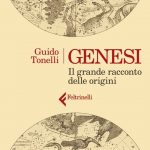“Genesis” by Guido Tonelli is a fascinating scientific story that traces the history of the universe in seven chapters. A mammoth task that the author, a physicist at CERN in Geneva and coordinator of one of the two groups of scientists that discovered the Higgs Boson, approaches with natural ease, in an easy-to-read book that steers as far away as possible from the specialist language of scientists in order to help the reader to understand highly-complex concepts, which discuss more than just astrophysics.
He writes:
It all starts with a simple and inevitable question: “Where does all this come from?”
This question still resonates today, all around the world, among individuals from very different cultures, a common theme of seemingly distant civilizations. It is a question that is asked by children and managers, scientists and shamans, astronauts and the last remaining populations of hunter-gatherers that survive in isolated areas of Borneo and Amazonia.
It is such a primordial question that some even believe that it has been handed down from the species that came before us.
 The story told in “Genesis” is an extraordinary one that, with its audacity and imagination, has a better plot than any science fiction novel: by applying the laws of quantum mechanics, we discover that the universe was created by a subtle transformation in the vacuum state, which then gradually produced space and time, matter and energy, the planets, the galaxies and all living beings.
The story told in “Genesis” is an extraordinary one that, with its audacity and imagination, has a better plot than any science fiction novel: by applying the laws of quantum mechanics, we discover that the universe was created by a subtle transformation in the vacuum state, which then gradually produced space and time, matter and energy, the planets, the galaxies and all living beings.
The shocking sequence of transformations gave created all forms of life is explained by the author in an interview:
In a magical moment, which we can today define as when one hundredth of a billionth of a second after the Big Bang the temperature dropped enough to ensure that the multitude of Higgs Bosons, which up until then roamed freely, were crystalized in a scalar field that occupied the entire universe. This newcomer separated weak interaction from electromagnetic interaction for good and assigned a specific mass to elementary particles that were thus able to group together to first form stable protons, then atoms, stars, galaxies and planets, and then us. These things, all things, including the life forms that were triggered at the peak of a long evolution, originated from the subtle imperfection that broke that perfect symmetry.
But how was it possible to reconstruct what happened more than 13 billion years ago with scientific precision?
Thanks to that marvellous machine that is known as a particle accelerator.
Particle accelerators are modern time machines: they take us back billions of years, allowing us to study phenomena at the roots of our universe. The vacuum is pummelled during collisions, and the result is material particles – an application of Einstein’s famous equivalence relation between mass and energy […] They are therefore factories of extinct particles that bring forms of matter that disappeared straight after the Big Bang back to life, for fractions of a second.
We can, of course, ask ourselves if are we really sure that is how things went. Let’s say that there is a good and reasonable chance that this reconstruction is really credible. We still need a lot more proof and there are still several grey areas, but the discoveries of recent decades have enabled us to have a precise understanding of the mechanisms that triggered the whole process.
In any case, the story of the origin of the universe that comes from modern science has a consistency and a completeness, but also a highly imaginative power, much greater that of any mythological tale. And it radically changes our way of looking at the world and placing ourselves within it:
Science goes ahead non-stop and changes the way we see and talk about the world. Each time this happens, everything changes. Not only for the tools and technology that result from it, but especially because, by changing the paradigms, all our relationships are changed. When we look at the world with different eyes, our culture, art and philosophy change. Hence, art, science and philosophy are still fundamental disciplines today, they give consistency to our human existence. This shared view of the world, which comes from our most distant past, is still the most appropriate tool we have to confront the challenges of the future.
Culture, the knowledge of our history and the story of our deepest roots are a kind of “superpower” that helps us to survive even in the most extreme conditions. Having an identity, being able to place our history, as well as that of the many people that have come before us in a long chain of events with its roots in a distant past, enables us to imagine a future:
That is why we are still here, thousands of generations later, to give meaning to art, philosophy and science. Because we are the heirs of this natural selection. The individuals and the groups most capable of developing a symbolic universe have enjoyed a great evolutionary advantage, and we are their descendants.

